Kentucky Pesticide Safety Education Program

Questions?
Contact
Dr. Ric Bessin
Dept. of Entomology
University of Kentucky
859-257-7450
rbessin@email.uky.edu
originally prepared by Jim Newman, Extension Forestry Specialist
updated by Jeff Stringer, Extension Forestry Specialist, and Lee Townsend, Extension Entomologist, University of Kentucky
Diseases
A plant disease usually results in abnormal growth and/or dysfunction of a plant. Living (pathogens) and non-living (environmental) factors are the main reasons that plants cannot function normally. Plant pathogens include fungi, bacteria, and occasionally viruses. Fungal pathogens are most common. They cause seed rots, seedling damping-off, root rots, foliage diseases, cankers, vascular wilts, diebacks, galls and tumors, trunk rots, and decays of aging trees. Abiotic factors, such as unfavorable weather, temperature and moisture extremes, high winds, or ice can damage trees directly and predispose them trees to pest attack.
Common Symptoms
Symptoms are the plant's reaction to the causal agent. Common symptoms include:
- Blight- a rapid discoloration and death of twigs, foliage, or flowers.
- Canker- Cankers are localized dead areas on the branches, twigs, or trunk of a tree. They can be caused by mechanical damage (especially weed whips and lawn mowers), environmental conditions (frost cracks, sunscald etc.), chemical injury, insects, or microorganisms (fungi and bacteria).
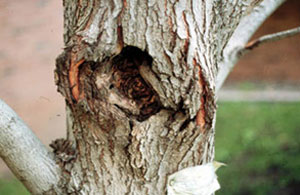
Canker on maple tree (Photo by C. Behrendt, University of Minnesota) - Chlorosis or yellowing- abnormal reduction or loss of the normal green color of leaves. Chlorosis is
so generic that diagnosis is impossible without additional details.
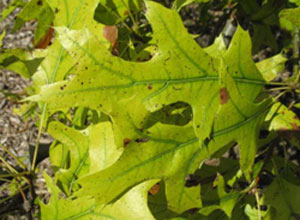
Chlorosis (missouribotanicalgarden.org) - Decline- Progressive decrease in plant vigor.
- Dieback- Progressive death of shoot, branch, or root starting at the tip.
- Distortion- Malformed plant tissue
- Gall- Abnormal localized swelling or enlargement of plant part. It could be caused by insects, mites, diseases, or abiotic disorders.
- Gummosis- Exudation of gum or sap.
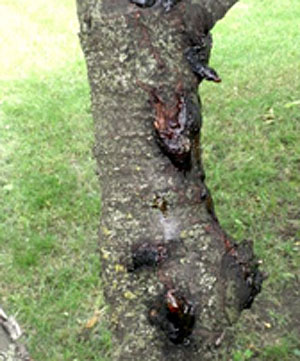
Gummosis is a sticky amber ooze or "gum" (ipm.iastate.edu) - Leaf distortion- The leaf could be twisted, cupped, rolled, or otherwise deformed.
- Leaf scorch- Burning along the leaf margin and into the leaf from the margin.
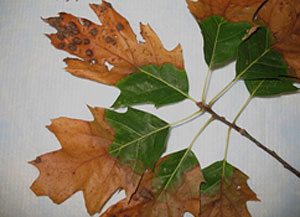
Bacterial leaf scorch (N. Gregory, University of Delaware) - Leaf spot- A spot or lesion on the leaf.
- Necrosis- dead tissue – Necrotic areas are also so generic that without additional details diagnosis is impossible.
- Stunting- Lack of growth
- Wilt- General wilting of the plant or plant part.
- Witches broom- Abnormal broom-like growth of many weak shoots.
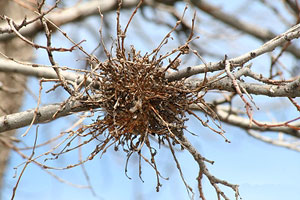
Witches broom (Whitney Cranshaw, Colorado State University, Bugwood.org)
[return]
Signs of Disease
Signs are the actual organisms causing the disease. Signs include:
- Conks- Woody reproductive structures of fungi that grow from the trunk or base of a tree.
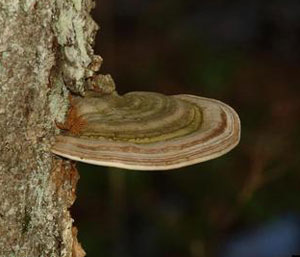
Artist's Conk (Becca MacDonald, Sault College, Bugwood.org) -
Fruiting bodies- Reproductive structures of fungi - mushrooms, puffballs, pycnidia, rusts, or conks.
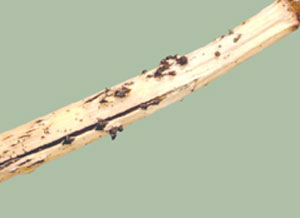
Black pycnidia of Diplopoda pinea from base of red pine needle (Photo by G. R. Stanosz) - Mildew- Whitish growth produced by fungi composed of mycelium.
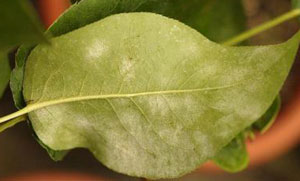
Powdery mildew
(Photo by Yuan-Min Sen, Taichung District Agricultural Research and Extension Station, Bugwood.org) - Mushrooms- Fleshy reproductive structures of fungi.
-
Mycelium- Thread-like vegetative growth of fungi.
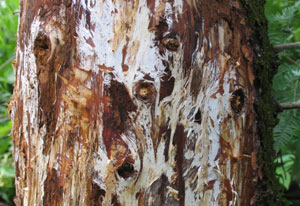
Mycelial mats of Armillaria root rot under the bark
(Joseph O'Brian, USDA Forest Service, Bugwood.org) - Rhizomorphs- Shoestring-like fungal threads found under the bark of stressed and dying trees caused by the Armillaria fungi.
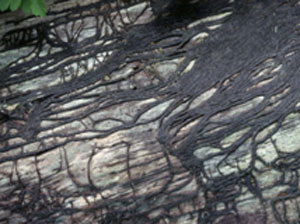
Rhizomorphs (atrium.lib.uogurlph.ca) - Slime flux or ooze- A bacterial discharge that oozes out of the plant tissues, may be gooey or a dried mass.
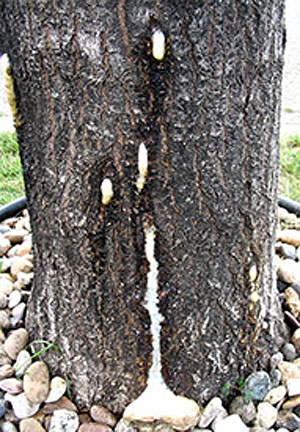
Slime flux on ash (extension.colostate.edu) - Spore masses- Masses of spores, the "seeds" of a fungus.
[return]
Fungi
Fungi are organisms that lack chlorophyll so they cannot produce their own food. They must obtain it from another source: decaying organic matter or from living plants. Parasitic fungi are the most common causes of plant diseases.
A fungus "body" is a branched filamentous structure known as mycelium. One single thread is called a hypha (hyphae, plural). Most fungi reproduce by spores, which are structures that contain little stored food (unlike seed). Spores are the main dispersal mechanism of fungi and can remain dormant until germination conditions are appropriate. Many fungi over-winter as fruiting structures embedded in dead plant tissue.
When a spore comes into contact with a susceptible plant, it will germinate and enter the host if the proper environmental conditions are present. Hyphae develop from the germinated spore and begin to take nutrients from host plant cells. The hyphae secrete enzymes to aid in the breakdown of organic materials that are ultimately absorbed through their cell walls. Fungi damage plants by killing cells and/or causing plant stress.
Fungi are spread by wind, water, soil, animals, equipment, and in plant material. They enter plants through natural openings such as stomata and lenticels and through wounds from pruning, hail, and other mechanical damage. Fungi can also produce enzymes that break down the cuticle (the outer protective covering of plants). They cause a variety of symptoms including leaf spots, leaf curling, galls, rots, wilts, cankers, and stem and root rots. Fungi are responsible for "damping off" symptoms associated with seedlings.
[return]
Bacteria
Bacteria are single-celled microorganisms that reproduce by dividing into two equal parts. As a result, they multiply and mutate rapidly. Like fungi, bacteria function as either parasites or saprophytes. Bacteria can infect all plant parts. Unlike fungi, bacteria must find a natural opening for entry. Bacterial cells can move from one plant to another in water, soil, and plant material, just as fungi do. However, bacterial pathogens are more dependent on water. Conditions must be very wet and/or humid for them to cause significant and widespread damage.
Bacteria move between plant cells and secrete substances that degrade cell walls. Some produce enzymes that break down plant tissue, creating soft rots or water-soaking. Like the fungi, bacteria cause symptoms such as leaf blights and spots, galls, cankers, wilts, and stem rots. Bacterial leaf spots appear different from fungal leaf spots due to their intercellular movement. Veins often limit the development of a lesion, so they appear angular or irregular, not round.
Comparison of Fungal and Bacterial Leaf Spots | ||
|---|---|---|
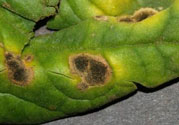 |
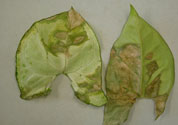 |
|
Symptom Description |
Fungus |
Bacterium |
Appear water-soaked |
No |
Yes |
Texture |
Dry, papery |
Slimy, sticky |
Smell |
No |
Yes |
Pattern |
Circular, target like |
Irregular, angular |
Color changes |
Red, yellow, purple halos |
No |
|
Structures |
Mycelia, spores, fruiting structures |
No |
[return]
Abiotic Disorders
Abiotic agents of disease are non-living factors such as soil compaction, spring frosts, hail, and mechanical damage to tree trunks. Abiotic agents are noninfectious and non-transmissible. Plant diseases deriving from these agents have been referred to as physiological diseases or environmental diseases.
Water Management
One of the major causes of abiotic plant disorders is improper water application. Too much water can be just as damaging as not enough water, as both kill roots. Examples of abiotic disorders related to water are leaf scorch, winter desiccation, and oxygen starvation.
Water stress on trees often shows from the top down.
Leaf Scorch
Symptoms of leaf scorch include necrosis (browning) of leaf edges and/or between the veins. These are naturally the least hydrated areas of a deciduous leaf, so when moisture is lost, symptoms appear there first. Scorch symptoms on needled evergreens appear as necrosis from the needle tips downward in a uniform pattern. The initial reaction to these symptoms is to provide more water, but that may only make the problem worse depending on what is causing the scorch.
There are several causes of leaf scorch. There may not be enough water in the soil for root absorption. Water may be lost faster than it can be replaced. Warm, windy, and sunny weather during winter months causes rapid transpiration at a time when soil moisture may be frozen. During summer, sunny, hot, and windy weather causes such rapid transpiration that roots cannot physically keep up with the water loss. Soil water may be available but roots may not be functioning properly to absorb it.
What causes roots to function poorly? Soil may be so compacted that roots cannot adequately explore soil for nutrients and moisture. Roots may be severed or otherwise damaged from attack by animal chewing or boring insects. A number of factors can result in more water is lost than can easily be replaced.
Oxygen Starvation
Oxygen starvation occurs when excess water in the soil drives out oxygen, in effect "suffocating" roots. Plants respond by dropping the lower leaves that are usually yellowed or necrotic. Leaf loss is most noticeable from the inside of the plant out and the bottom up. In addition, leaves may be smaller than normal, growth increments may be small, and the plant may have an overall unthrifty appearance.
While oxygen starvation causes root damage, the first clue that something is wrong appears on the canopy, stems, and branches. These parts are the furthest from the water source, so the symptoms appear there first. To control problems caused by water management issues, identify the likely causes and correct them if possible. This will require some detective work to determine which factor or (usually) combination of factors is causing the problem.
Weather
Winter desiccation is caused by dry winter winds that result in leaf water loss. Water cannot be replaced in the plant because the soil is too cold and roots cannot absorb it. Symptoms of winter desiccation include necrotic leaf or needle tissue (typically from the tips inward), discoloration of needle or leaf tissue, and patchy damage distribution on individual plants in windy locations. Plants may not exhibit symptoms until the following summer when droughty summer conditions ensue.
Winter dehydration on pine shows at needle tips. Roots are still active and can absorb water until soil temperatures drop below 40°F.
Temperature
Temperatures below optimal plant growth cause plant damage. The amount and type of damage depends on how quickly temperatures drop, the lowest temperature reached, and how long cold temperatures are sustained. Freeze injury may be caused by frost crystals that form in the freezing water outside of plant tissues or by freezing water inside plant cells. Damage from the latter is much more severe and resembles herbicide phytotoxicity, bacterial blight, and branch flagging due to insect borer activity.
Southwest bark injury on trees is a combination of rapid winter temperature change coupled with winter drought Spring freezes damage exterior buds first, as these are the first to de-harden. Fall freezes affect interior buds first as these are the last to harden. Damage of tissues is uniform. For example, newly developing conifer needles may be killed completely or from the tips inward. Temperatures above optimal growth cause plant damage, as well. The most severe injury occurs on leaves that are exposed to the sun and tissue that is furthest away from water such as outer branch tips, leaf margins, and between leaf veins.
Chemical Injury
Chemical injury is plant damage caused by pesticides, fertilizers, de-icing salts, and other products.
Herbicides
Herbicides (weed killers) damage plant tissues by causing symptoms such as chlorosis, necrosis, distortion, and elongated growth. Glyphosate, dicamba, and 2,4-D are examples of common herbicides that cause chemical injury to desirable plants when used incorrectly. Herbicides that behave like PGRs (plant growth regulators), such as dicamba and 2,4-D translocate through both the xylem and phloem. They stimulate growth such as cell division, elongation, and fruit and flower production.
Excessive concentrations of these chemicals cause twisting and curling of stems, stem swelling, weakened cell walls, rapid cell growth, and cellular and vascular damage and death. Grasses are not affected by plant growth regulators apparently due to a different arrangement of vascular bundles (xylem and phloem). Glyphosate is an amino acid inhibitor that interferes with synthesis of certain amino acids needed to build proteins. Glyphosate moves through the phloem to the new growth of shoots and roots. Injury symptoms include chlorosis, shortened internodes (compact growth or stunting), stem proliferation, and mimics damage caused by 2,4-D and other plant growth regulators, viruses, phytoplasmas, eriophyid mites, and environmental factors.
Fertilizers
An excess or shortage of the 17 essential elements required for plant growth and development may cause plant damage. Excess amounts of fertilizers can "burn" plants due to the level of salts in fertilizers. Symptoms of fertilizer damage include leaf margin necrosis (similar to drought stress in appearance), leaf discoloration, soft rapid growth, and vegetative growth at the expense of flower and fruit production. Nutrient deficiencies include chlorosis, interveinal chlorosis, blossom-end rot, stunting, and purpling.
Symptoms of nutrient excesses and deficiencies may be confused with disease, insect, mite, or other environmental problems. If a soil nutritional problem or salt injury is suspected, have the soil tested. When excess fertilizer has been applied, apply water in an effort to leach salts from the root zone. Quick release fertilizers are more prone to "burn" plants. Follow label directions when applying fertilizers to avoid plant damage.
[return]
References
Brooks, R. Forest Herbicides and their mode of action. U of Idaho CES Tree Planting and Care No. 15. Forest pest control. U Ga Special Bulletin 16 http://www.bugwood.org/pestcontrol/ Invasive plants of the eastern United States: Identification and Control. http://www.invasive.org/eastern Kentucky Woodlands Magazine Vol 1. SAF.
Herbicide use in forest management - a position of the Society of American Foresters. This publication, originally prepared by Jim Newman, Extension Forestry Specialist, is provided by the Pesticide Safety Education Program of the UK College of Agriculture. This version has been updated by Jeff Stringer, Extension Forestry Specialist, and Lee Townsend, Extension Entomologist.
http://www.ext.colostate.edu/mg/Gardennotes/331.pdf
1) A _________ is a rapid discoloration and death of tree foliage.
2) _____________ is an abnormal loss of normal green leaf color.
3) __________ is a burning that moves into the leaf from its margin.
4) __________ are very dependent upon water to spread from plant to plant.
5) _________ are identified by mycelia, spores, and fruiting structures.
6) Many plants respond to oxygen starvation by dropping the lower leaves that are usually yellowed or necrotic.
photo credits: banner image - Jerry A. Payne, USDA Agricultural Research Service, Bugwood.org
website content by L. Townsend website design by P. Dillon copyright © 2016 University of Kentucky Department of Entomology
University of Kentucky College of Agriculture |
S-225 Agricultural Science Center North, Lexington, KY 40546-0091 | 859.257.7450
An Equal Opportunity University |
Last modified
11/30/2018
